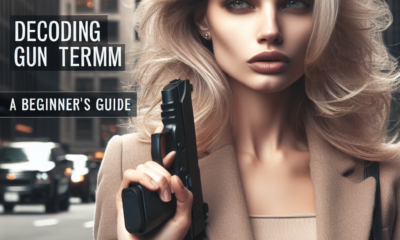Womens Firearms
A Crash Course in Gun Terminology: Understanding the Basics

Hello, ladies! I’m Jade Tripp, and I’m thrilled to guide you through the essential terminology related to firearms. Whether you’re just beginning your journey into the world of self-defense or looking to enhance your existing knowledge, understanding basic gun terminology can empower your experience and boost your confidence. Let’s embark on this journey together!
1. The Basics of Firearm Types
Handguns, Rifles, and Shotguns: The three main types of firearms.
- Handguns are compact and typically designed for one-handed use. Think of your common pistol, like the Glock 19 or the Smith & Wesson M&P Shield, which is ideal for personal defense.
- Rifles are long-barreled firearms designed for accuracy over longer distances. For example, the AR-15 is popular for target shooting and hunting.
- Shotguns are mainly used for close-range shooting. They’re versatile, with models like the Remington 870 being widely used in home defense.
Understanding these types will help you choose the right firearm for your needs and comfort level.
2. Understanding Caliber and Gauge
Caliber refers to the internal diameter of a firearm barrel and thus the size of the bullet it fires. For instance, a .40 caliber handgun is different from a 9mm handgun. Each has its advantages and disadvantages based on your needs, such as recoil and stopping power.
Gauge pertains to shotguns. The most common gauge is 12-gauge, which signifies the diameter of the shotgun barrel. Shotgun prices and ammunition types can vary widely, so familiarize yourself with these specifications as well!
3. Terminology You’ll Encounter
-
Action: This refers to how a firearm operates, such as semi-automatic, fully automatic, or manual (like a revolver). A semi-automatic pistol, for instance, fires one round for each pull of the trigger without needing a manual action to load the next round.
-
Magazine vs. Clip: A magazine is a device that holds ammunition and is inserted into or attached to a firearm. A clip, on the other hand, is a device used to hold bullets together, allowing for easy loading into a magazine. Understanding this difference can help you communicate more effectively in discussions or while training.
- Safety: This is an essential feature designed to prevent accidental discharges. Always check your firearm for safety features, and familiarize yourself with how they function.
4. Ammunition Basics
-
Bullet: This is the projectile that is fired from the cartridge. Understanding the types of bullets—like hollow point (designed to expand upon impact) versus full metal jacket—is crucial for self-defense considerations.
- Cartridge: This is the complete unit that a gun fires, comprising the bullet, gunpowder, and casing. Knowing how cartridges are constructed helps you appreciate the mechanics of firearms.
5. Real-World Application
Consider the journey of a woman like Ayo Kim, who undertook firearms training after experiencing an unsettling incident. Initially intimidated, Ayo empowered herself by becoming well-versed in gun terminology and safety procedures. Now, she understands not only her firearm but also engages in conversations about self-defense confidently.
6. Safety First
Always remember that safety should be your number one priority. Familiarize yourself with the “Four Rules of Gun Safety”:
- Treat every firearm as if it were loaded.
- Never point the firearm at anything you are not willing to destroy.
- Keep your finger off the trigger until you are ready to shoot.
- Be sure of your target and what’s beyond it.
7. Continued Learning
Learning about firearms and self-defense is a continuous journey. Consider joining women-centered firearm training classes or groups, like A Girl and a Gun, which fosters a supportive environment for women to learn and share experiences.
Understanding gun terminology opens up a world of possibilities in self-defense training. As you become familiar with these terms, your confidence will grow, and you’ll feel empowered to take your safety into your own hands. Remember, ladies: knowledge is power, and that power is yours to wield! Stay safe and stay informed!
Womens Firearms
How Gun Safety Certifications Can Prevent Tragedies

Hello, ladies! I’m Jade Tripp, and I’m thrilled to talk to you about a vital topic in the realm of self-defense: gun safety certifications. As women, it’s essential to feel empowered, educated, and safe, especially if you’re considering incorporating firearms into your personal safety plan. Understanding the significance of gun safety certifications can not only enhance your skills but can also save lives.
The Importance of Gun Safety Certifications
Firearms can be powerful tools for self-defense, but with great power comes great responsibility. According to the National Safety Council, unintentional shootings led to more than 500 deaths and 16,000 injuries in the U.S. in recent years. These tragedies often stem from a lack of education and safety measures. That’s where gun safety certifications come in!
What Are Gun Safety Certifications?
Gun safety certifications are structured courses designed to teach individuals how to handle firearms safely and responsibly. These courses often cover topics like:
- Firearm Types: Understanding different firearms and their mechanisms.
- Safe Handling: Best practices for handling guns safely, including how to store and transport them.
- Shooting Fundamentals: Basic shooting techniques, including aiming, stance, and follow-through.
- Legal Responsibilities: Knowing your rights and responsibilities regarding firearm ownership and use.
Real Stories, Real Impact
The Case of Niki O’Connor
Let me share a heartwarming success story that illustrates the importance of gun safety certification. Niki O’Connor, a single mother from Arizona, took a gun safety course after a difficult experience during her night shift at a local convenience store. Feeling vulnerable after being approached aggressively one evening, she decided it was time to learn how to protect herself—should the need ever arise.
After completing a safety certification course, Niki not only gained confidence in handling a firearm, but she also became an advocate for women’s self-defense. Her new skills ensured that when she purchased her first firearm—a compact pistol suitable for concealed carry—she knew exactly how to handle it safely. Today, she teaches classes for other women in her community, emphasizing the importance of education in preventing tragedy.
A Community Effort: The Well-Armed Woman
Another fantastic example of the impact of gun safety certifications can be seen in the organization "The Well-Armed Woman." Founded by Carrie Lightfoot, this initiative aims to educate and empower women in their journey towards responsible gun ownership. Their locally hosted events provide an environment for women to learn, ask questions, and practice their skills in a supportive atmosphere.
Through their resources, women have learned not only about gun safety but about the importance of being prepared in different scenarios. With a focus on community and empowerment, they’ve trained thousands of women to protect themselves effectively and knowledgeably.
Reducing Accidental Shootings
Statistics show that 1 in 3 homes with children have firearms, and about 43% of child-related gun deaths are due to unintentional shootings. Imagine the impact if all gun owners underwent safety certification! Courses emphasize safe storage practices, including using gun safes and trigger locks. By keeping firearms secure and inaccessible to children, we can dramatically reduce the chances of accidental shootings.
Finding Your Course
If you’re considering a gun safety certification, here are a few steps to get started:
-
Research: Look for local courses in your area through credible organizations, ranges, or community colleges.
-
Ask Questions: Don’t hesitate to inquire about the instructors’ backgrounds, course content, and certification recognition.
-
Be Open-Minded: Remember that everyone learns at their own pace. Don’t be discouraged if you feel overwhelmed at first; practice makes perfect!
- Engage with Your Community: Connect with other women in your area who are interested in self-defense. It can be comforting to learn alongside others who share similar goals.
Conclusion
Gun safety certifications are more than just a piece of paper; they’re a commitment to responsible firearm ownership and a pledge to keep ourselves and others safe. By taking this proactive step, we can turn potential tragedies into stories of triumph and empowerment.
Empowered women empower women—and together, we can create safer communities. So, ladies, let’s embrace knowledge, embrace safety, and most importantly, let’s embrace our right to protect ourselves!
Stay safe, stay educated, and remember: preparedness is your best friend.
Womens Firearms
Defending Yourself: A Woman’s Guide to Self-Defense Rights

Hello, ladies! I’m Jade Tripp, and today we’re diving into an essential topic: your rights in self-defense situations. It’s empowering to know
what you can do to protect yourself and, most importantly, to understand the laws that govern self-defense in your area. Let’s break it down together!
Understanding Your Rights
First and foremost, let’s clarify that self-defense laws can vary significantly depending on where you live. In many places, you have the right to defend yourself if you believe you’re in immediate danger. Here are a few key concepts to consider:
-
Reasonable Force: You can use reasonable force to defend yourself. This means the level of force you use must be proportional to the threat. For example, if someone is trying to shove you, responding with a kick might be seen as reasonable. But if they’re simply yelling, using a weapon could be excessive.
-
Duty to Retreat: Some states have a “duty to retreat” law, which requires you to escape if possible before using force. Others have “stand your ground” laws, meaning you can defend yourself without first retreating. Familiarize yourself with local statutes. Websites like the National Rifle Association (NRA) or local law enforcement agencies often have resources.
- Self-defense and Threat Perception: Your perception of the threat is crucial. As a woman, being aware of your surroundings and assessing situations is key. Trust your instincts! If something feels off, it often is.
Real-Life Scenario: Know the Law
Consider the case of Marissa Alexander, a Florida woman who was sentenced to 20 years for firing a warning shot during a domestic dispute. Her situation was convoluted, but it shines a light on the importance of knowing how self-defense laws are applied in your area. After her case garnered national attention, the laws surrounding self-defense and gun use became a topic of widespread discussion.
Empowerment Through Knowledge
Understanding your rights isn’t just about knowing what to do in a moment of danger. It empowers you to recognize the importance of self-defense training and awareness.
Take Action!
-
Self-Defense Classes: Engage in self-defense classes tailored for women. Look for local programs offered by organizations like the Rape Aggression Defense (RAD) System, which focuses on practical techniques.
-
Firearms Training: If you choose to go this route, enroll in a certified firearms safety course. I highly recommend the “Women on Target” program by the NRA, which helps demystify firearms and teaches basic shooting skills in a supportive environment.
- Situational Awareness: Practice being aware of your surroundings. This means not just watching for potential threats, but also recognizing safe spaces and exits when you’re out—whether that’s in a parking lot, at a bar, or even in your neighborhood.
Finding Support in Your Community
Reach out to local women’s groups or self-defense organizations. These communities can provide you with resources, encouragement, and a safe space to learn. For example, Girl Scouts of America sometimes offer safety and self-defense workshops through their local councils. Seek them out!
Creating Your Safety Plan
Have a safety plan in place. Here’s what you can do:
-
Communicate with Others: Share your plans with trusted friends or family. Having a “safety buddy” system can help you feel more secure.
-
Download Safety Apps: Apps like bSafe can allow you to alert someone in case of an emergency. Just a click of a button can make a significant difference!
- Practice Your Skills: Regularly go over what you’ve learned in self-defense classes or firearms training. Like any skill, practice makes perfect!
Be Your Own Advocate
Remember, ladies, your safety is paramount. If you ever find yourself in a situation where you need to defend yourself and feel like the law wasn’t on your side, seek out legal assistance immediately. Organizations like the Women’s Law Project can offer guidance and support.
Final Thoughts
Self-defense is not just about physical strength; it’s about awareness, confidence, and understanding your rights. Empower yourself with knowledge and skills, create supportive networks, and always trust your instincts. Each of us has the right to feel safe and secure in our own lives.
Stay strong and empowered, ladies! Together, we can build a safer future for ourselves and each other. Let’s get out there and show the world that we’ve got what it takes to protect ourselves!
With love and strength,
Jade Tripp
Womens Firearms
Female Thigh Holster Review: Dene Adams Thigh Holster Shorts | Geauga Firearms Academy

Check out our website for up coming training classes and services http://bit.ly/GFAcademy In this Kim’s Corner brought yo you by …
source
-

 Womens Self Defense11 months ago
Womens Self Defense11 months agoNew Legislation Empowers Women to Defend Themselves
-

 Self Defense News1 year ago
Self Defense News1 year agoShe was convicted of killing her abusive boyfriend. Now a Maple Grove woman is home awaiting a new trial.
-

 Self Defense News1 year ago
Self Defense News1 year agoSelf-Defense for All: The new Gracie Jiu-Jitsu Pasadena is for everyone | Online Features
-

 Womens Self Defense8 months ago
Womens Self Defense8 months agoUnderstanding State-by-State Variation in Self Defense Laws
-

 Womens Self Defense1 year ago
Womens Self Defense1 year agoTop 5 Self-Defense Techniques Every Woman Should Know
-

 Womens Fitness1 year ago
Womens Fitness1 year agoXtreme Bodyweight HIIT (Lots of Jumping!) | Joanna Soh (Fio Series)
-

 Womens Preparedness1 year ago
Womens Preparedness1 year agoEmpower Yourself: A Guide to Female Survival Planning
-

 Womens Preparedness1 year ago
Womens Preparedness1 year ago10 essential skills for surviving in the great outdoors









